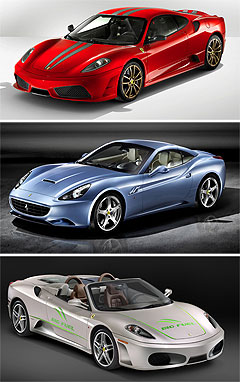Make / Model Search
News - FerrariFerrari to stay red, but think greenFuture-proofing: Hybrid drive systems, supercharging, kinetic energy recovery systems and bio-fuel compatibility are all on the agenda for Ferrari's next-generation engines. Turbocharged V6 model on the cards as Ferrari looks to stay red while turning green1 Jul 2008 By DAVID HASSALL in ITALY FERRARI may build a new turbocharged V6 model by 2015 as part of a potentially radical plan being formulated this year to ensure its famed sportscars meet tougher environmental standards well into the next decade. The Prancing Horse brand is also working on hybrid drive systems, supercharging, kinetic energy recovery systems and bio-fuel compatibility with a view to reducing fuel consumption and exhaust emissions without reducing performance. Ferrari GT car technical director Roberto Fedeli revealed to GoAuto and one other Australian journalist at Maranello on Friday (June 27) that a turbocharged engine was one of the R&D projects in development and that it would be smaller in capacity and size than Ferrari’s traditional V8 and V12 engines. Mr Fedeli told us that applying turbocharging or supercharging to ‘normal’ Ferrari engines would not make sense because they would develop far too much power, which indicates that the engine would be a more compact and lighter V6, with which Ferrari also has a long and proud tradition with its Dino models. Asked if Ferrari was working on a turbo, Mr Fedeli left no room for misunderstanding when he said: “Yes, for sure”.  Left: Scuderia, California and F430 Spider bio-fuel. Left: Scuderia, California and F430 Spider bio-fuel.“Within two years we will define the right engine that we develop for 2013 to 2016. Now we have to look at it with a very open mind for the solutions. “We can’t build a ‘normal’ turbocharged engine we have to push a lot with the specific power-per-litre. This means that you can’t put on the car 1000 horsepower. It doesn’t make sense. “If you want to push up the specific power for the engine, the dimension of the engine can’t be very big.” However, Ferrari press office chief Davide Kluzer said that this does not mean that the Scuderia will use a more compact engine to build another Dino, a smaller, less powerful and cheaper model that could be seen as a Porsche Boxster rival. ‘Dino’ was the name of Enzo Ferrari’s son, who died as a young man and whose name was immortalised with a series of V6-powered ‘baby Ferrari’ road and race cars. “The Dino has been a glorious part of our past, but we don’t need or want to build another Dino,” said Mr Kluzer. “We don’t have to turbocharge our cars, but if turbo helps consumption, then why not? “Ferrari is always looking ahead at the best technical solution available. The only one we will never do is a four-door car because it is not a sportscar. And we will never do an SUV.” Just two days after Ferrari president Luca di Montezemolo presented the world media with the latest phase of Formula Uomo – the company’s plan to modernise and make the famous Maranello plant more green – Mr Fedeli said there is also a two-stage plan to improve the environmental performance of its cars. The first stage (or ‘loop’) is a 40 per cent reduction in fuel consumption and CO2 emissions by 2012, a target that was outlined by the company last year to meet future European Commission requirements. Mr Fedeli also revealed that direct injection, which Ferrari will use for the first time on the new California’s V8 engine from late this year, will be applied to all of its V8 and V12 models in the next “three years, not more” to help reach the 2012 target. Direct injection – along with a new seven-speed dual-clutch transmission – will see the California return 25 per cent better fuel economy than the similarly engined F430. The ‘first loop’ began at Maranello three years ago and resulted in last year’s release of the lightweight F430 Scuderia with its more efficient V8 engine, and the 599 Fiorano that has a bigger and more powerful V12 engine than the 575 it replaced but is 60kg lighter and uses no more fuel. It also led to the development of a flex-fuel V8 engine that will run on E85 (85 per cent ethanol) fuel, producing more power but five per cent lower emissions. This was revealed in an F430 Spider concept car at the Detroit motor show in January. However, it is the next stage of the plan that has Mr Fedeli and his technical group really excited because it involves thinking of new ideas and developing new technologies. These will be considered throughout the course of this year, the most viable will be developed “in the next year or two” and the first results of the program will begin to appear in the market in about “five to six years starting from now”. “The time for developing the engines is very long, so from the beginning of this year we are working very hard in the preliminary phase of the development of the new family of engines. “As usual in Ferrari, we will develop more than one technology solution this year in order to choose the right solution in one or two years. “But in the next six months we are just thinking for the future,” he said with a satisfied smile. “Let me say, it’s a very fun phase.” Read more:Ferrari's flip-top California turns blueFirst look: Front-engined Fazza breaks new ground Smoother Scaglietti now on sale |
Click to shareFerrari articlesResearch Ferrari Motor industry news |









Facebook Twitter Instagram